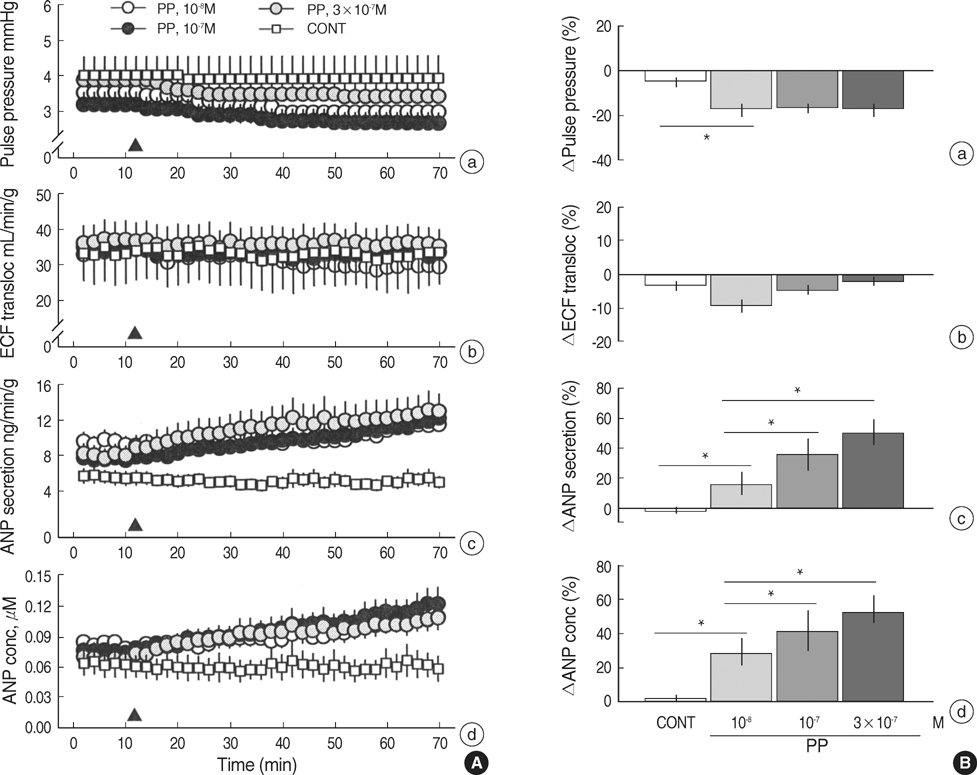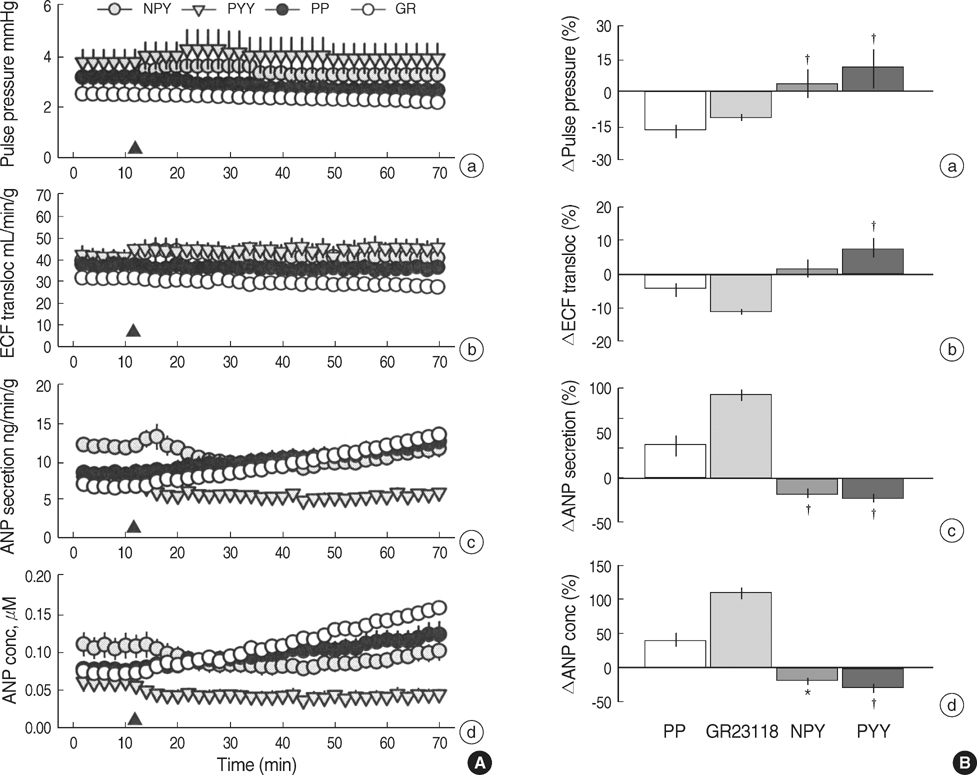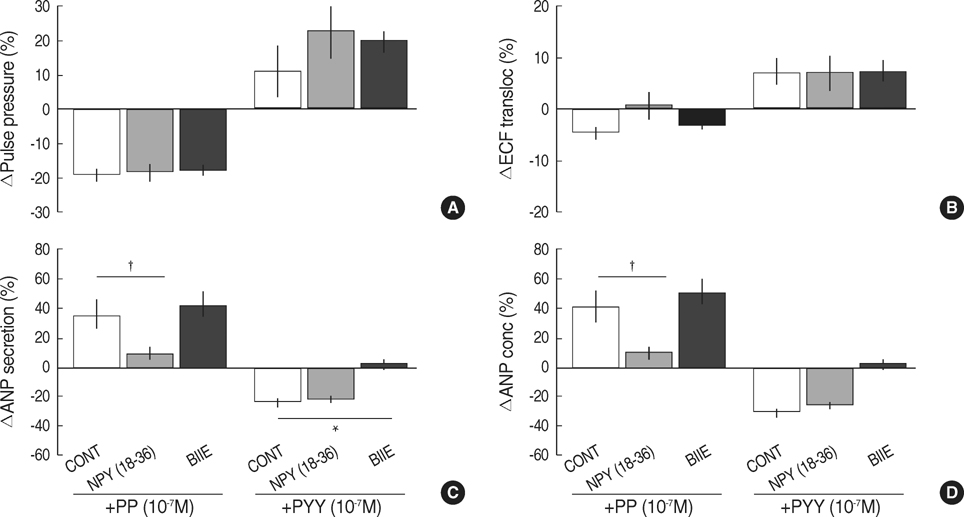J Korean Med Sci.
2008 Dec;23(6):1027-1032. 10.3346/jkms.2008.23.6.1027.
Different Regulation of Atrial ANP Release through Neuropeptide Y2 and Y4 Receptors
- Affiliations
-
- 1Department of Physiology, Medical Sciences, Chonbuk National University Medical School, Jeonju, Korea. shkim@chonbuk.ac.kr
- 2College of Nursing, Yanbian University, Yanji, China.
- KMID: 1107529
- DOI: http://doi.org/10.3346/jkms.2008.23.6.1027
Abstract
- Neuropeptide Y (NPY) receptors are present in cardiac membranes. However, its physiological roles in the heart are not clear. The aim of this study was to define the direct effects of pancreatic polypeptide (PP) on atrial dynamics and atrial natriuretic peptide (ANP) release in perfused beating atria. Pancreatic polypeptides, a NPY Y4 receptor agonist, decreased atrial contractility but was not dose-dependent. The ANP release was stimulated by PP in a dose-dependent manner. GR 23118, a NPY Y4 receptor agonist, also increased the ANP release and the potency was greater than PP. In contrast, peptide YY (3-36) (PYY), an NPY Y2 receptor agonist, suppressed the release of ANP with positive inotropy. NPY, an agonist for Y1, 2, 5 receptor, did not cause any significant changes. The pretreatment of NPY (18-36), an antagonist for NPY Y3 receptor, markedly attenuated the stimulation of ANP release by PP but did not affect the suppression of ANP release by PYY. BIIE0246, an antagonist for NPY Y2 receptor, attenuated the suppression of ANP release by PYY. The responsiveness of atrial contractility to PP or PYY was not affected by either of the antagonists. These results suggest that NPY Y4 and Y2 receptor differently regulate the release of atrial ANP.
Keyword
MeSH Terms
Figure
Reference
-
1. Larhammar D. Evolution of neuropeptide Y, peptide YY and pancreatic polypeptide. Regul Pept. 1996. 62:1–11.
Article2. Allen J, Novotny J, Martin J, Heinrich G. Molecular structure of mammalian neuropeptide Y: analysis by molecular cloning and computer-aided comparison with crystal structure of avian homologue. Proc Natl Acad Sci USA. 1987. 84:2532–2536.
Article3. MacKerell AD Jr, Hemsen A, Lacroix JS, Lundberg JM. Analysis of structure-function relationships of neuropeptide Y using molecular dynamics simulations and pharmacological activity and binding measurements. Regul Pept. 1989. 25:295–313.
Article4. Ekblad E, Sundler F. Distribution of pancreatic polypeptide and peptide YY. Peptides. 2002. 23:251–261.
Article5. Michel MC, Beck-Sickinger A, Cox H, Doods HN, Herzog H, Larhammar D, Quirion R, Schwartz T, Westfall T. XVI. International Union of Pharmacology recommendations for the nomenclature of neuropeptide Y, peptide YY, and pancreatic polypeptide receptors. Pharmacol Rev. 1998. 50:143–150.6. Goumain M, Voisin T, Lorinet AM, Laburthe M. Identification and distribution of mRNA encoding the Y1, Y2, Y4, and Y5 receptors for peptides of the PP-fold family in the rat intestine and colon. Biochem Biophys Res Commun. 1998. 247:52–56.7. Gregor P, Millham ML, Feng Y, DeCarr LB, McCaleb ML, Cornfield LJ. Cloning and characterization of a novel receptor to pancreatic polypeptide, a member of the neuropeptide Y receptor family. FEBS Lett. 1996. 381:58–62.
Article8. Whitcomb DC, Vigna SR, McVey DC, Taylor IL. Localization and characterization of pancreatic polypeptide receptors in rat adrenal glands. Am J Physiol. 1992. 262:G532–G536.
Article9. Bard JA, Walker MW, Branchek TA, Weinshank RL. Cloning and functional expression of a human Y4 subtype receptor for pancreatic polypeptide, neuropeptide Y, and peptide YY. J Biol Chem. 1995. 270:26762–26765.
Article10. Walker MW, Smith KE, Bard J, Vaysse PJ, Gerald C, Daouti S, Weinshank RL, Branchek TA. A structure-activity analysis of the cloned rat and human Y4 receptors for pancreatic polypeptide. Peptides. 1997. 18:609–612.
Article11. Rogers RC, McTigue DM, Hermann GE. Vagal control of digestion: Modulation by central neural and peripheral endocrine factors. Neurosci Biobehav Rev. 1996. 20:57–66.
Article12. Lundberg JM, Terenius L, Hokfelt T, Goldstein M. High levels of neuropeptide Y in peripheral noradrenergic neurons in various mammals including man. Neurosci Lett. 1983. 42:167–172.
Article13. Smith-White MA, Herzog H, Potter EK. Cardiac function in neuropeptide Y Y4 receptor-knockout mice. Regul Pept. 2002. 110:47–54.14. Smith-White MA, Herzog H, Potter EK. Role of neuropeptide Y Y(2) receptors in modulation of cardiac parasympathetic neurotransmission. Regul Pept. 2002. 103:105–111.
Article15. Kilborn MJ, Potter EK, McCloskey DI. Neuromodulation of the cardiac vagus: comparison of neuropeptide Y and related peptides. Regul Pept. 1985. 12:155–161.
Article16. Han JH, Cao C, Kim SZ, Cho KW, Kim SH. Decreases in ANP secretion by lysophosphatidylcholine through protein kinase C. Hypertension. 2003. 41:1380–1385.
Article17. Cho KW, Seul KH, Kim SH, Seul KM, Ryu H, Koh GY. Reduction volume dependence of immunoreactive atrial natriuretic peptide secretion in isolated perfused rabbit atria. J Hypertens. 1989. 7:371–375.
Article18. Cho KW, Seul KH, Kim SH, Koh GY, Seul KM, Hwang YH. Sequential mechanism of atrial natriuretic peptide secretion in isolated perfused rabbit atria. Biochem Biophys Res Commun. 1990. 172:423–431.
Article19. Cho KW, Kim SH, Hwang YH, Seul KH. Extracellular fluid translocation in perfused rabbit atria: implication in control of atrial natriuretic peptide secretion. J Physiol. 1993. 468:591–607.
Article20. Lundell I, Statnick MA, Johnson D, Schober DA, Starback P, Gehlert DR, Larhammar D. The cloned rat pancreatic polypeptide receptor exhibits profound differences to the orthologous receptor. Proc Natl Acad Sci USA. 1996. 93:5111–5115.
Article21. Barrios VE, Sun J, Douglass J, Toombs CF. Evidence of a specific pancreatic polypeptide receptor in rat arterial smooth muscle. Peptides. 1999. 20:1107–1113.
Article22. Parker SL, Parker MS, Crowley WR. Characterization of Y1, Y2 and Y5 subtypes of the neuropeptide Y (NPY) receptor in rabbit kidney. Sensitivity of ligand binding to guanine nucleotides and phospholipase C inhibitors. Regul Pept. 1998. 75-76:127–143.23. McTigue DM, Rogers RC. Pancreatic polypeptide stimulates gastric motility through a vagal-dependent mechanism in rats. Neurosci Lett. 1995. 188:93–96.
Article24. Yan H, Yang J, Marasco J, Yamaguchi K, Brenner S, Collins F, Karbon W. Cloning and functional expression of cDNAs encoding human and rat pancreatic polypeptide receptors. Proc Natl Acad Sci USA. 1996. 93:4661–4665.
Article25. Movafagh S, Hobson JP, Spiegel S, Kleinman HK, Zukowska Z. Neuropeptide Y induces migration, proliferation, and tube formation of endothelial cells bimodally via Y1, Y2, and Y5 receptors. FASEB J. 2006. 20:1924–1926.26. Parker MS, Lundell I, Parker SL. Pancreatic polypeptide receptors: affinity, sodium sensitivity and stability of agonist binding. Peptides. 2002. 23:291–303.27. Moro C, Galitzky J, Sengenes C, Crampes F, Lafontan M, Berlan M. Functional and pharmacological characterization of the natriuretic peptide-dependent lipolytic pathway in human fat cells. J Pharmacol Exp Ther. 2004. 308:984–989.
Article
- Full Text Links
- Actions
-
Cited
- CITED
-
- Close
- Share
- Similar articles
-
- Ca2+-induced Ca2+ Release from Sarcoplasmic Reticulum Negatively Regulates Myocytic ANP Release in Beating Rabbit Atria
- Differential Regulation of Atrial Natriuretic Peptide in Clipped and Contralateral Kidneys in Two-Kidney, One Clip Hypertension
- Atrial Natriuretic Peptide System in Eyes
- Atrial natriuretic peptide induces rat peritoneal mast cell activation by cGMP-independent and calcium uptake-dependent mechanism
- Immunohistochemical Localization of Alpha-Atrial Natriuretic Polypeptide in the Human Nasal Polyp




